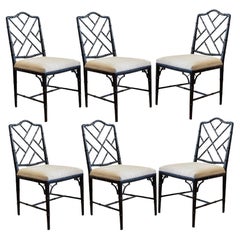8 Faux Bois Bamboo Chinese
Recent Sales
Mid-20th Century American Chinese Chippendale Dining Room Chairs
Wood, Upholstery
Mid-20th Century American Chinese Chippendale Dining Room Chairs
Upholstery, Wood
A Close Look at chinese-chippendale Furniture
Like chinoiserie, which had emerged in Europe in the 17th century, antique Chinese Chippendale furniture was an appropriation of Asian design that often distilled it to stereotypes.
Thomas Chippendale published The Gentleman and Cabinet-Maker’s Director in 1754, and the widespread popularity of the book of furniture designs influenced a new style of furniture named for the English cabinetmaker. Artisans in England, the United States and Europe adapted the work illustrated in its pages. The publication of the pattern book included designs reflecting “Gothic, Chinese and Modern Taste,” with illustrations of “Chinese” chairs and cabinets featuring elaborate hand-carved latticework.
Pagoda-shaped flourishes and wood painted in the “japanned” finish that mimicked lacquer were common on these pieces, as were fretwork patterns on chair backs. The back of a chair is the easiest way to distinguish between Gothic, Rococo and Chinese Chippendale chairs, all of which typically feature broad seats and luxurious upholstery. Chippendale’s designs for “Chinese” chairs tend to favor more clean lines and less ornamentation than the other styles, with cutouts in the rails and the fretwork on the back evoking a European ideal of East Asian design.
Dark woods such as walnut and solid mahogany were commonly used, as were bamboo turnings. Cabinets for imported Chinese ceramics frequently were adorned with glazing bars, while small tea tables were detailed with angular fretwork. The style remained popular through the 18th century and into the decades that followed, even inspiring an entire room at Buckingham Palace.
Find antique Chinese Chippendale dining room chairs, side tables, case pieces and other furniture and decor on 1stDibs.
Finding the Right chairs for You
Chairs are an indispensable component of your home and office. Can you imagine your life without the vintage, new or antique chairs you love?
With the exception of rocking chairs, the majority of the seating in our homes today — Windsor chairs, chaise longues, wingback chairs — originated in either England or France. Art Nouveau chairs, the style of which also originated in those regions, embraced the inherent magnificence of the natural world with decorative flourishes and refined designs that blended both curved and geometric contour lines. While craftsmanship and styles have evolved in the past century, chairs have had a singular significance in our lives, no matter what your favorite chair looks like.
“The chair is the piece of furniture that is closest to human beings,” said Hans Wegner. The revered Danish cabinetmaker and furniture designer was prolific, having designed nearly 500 chairs over the course of his lifetime. His beloved designs include the Wishbone chair, the wingback Papa Bear chair and many more.
Other designers of Scandinavian modernist chairs introduced new dynamics to this staple with sculptural flowing lines, curvaceous shapes and efficient functionality. The Paimio armchair, Swan chair and Panton chair are vintage works of Finnish and Danish seating that left an indelible mark on the history of good furniture design.
“What works good is better than what looks good, because what works good lasts,” said Ray Eames.
Visionary polymaths Ray and Charles Eames experimented with bent plywood and fiberglass with the goal of producing affordable furniture for a mass market. Like other celebrated mid-century modern furniture designers of elegant low-profile furnishings — among them Ludwig Mies van der Rohe and Finn Juhl — the Eameses considered ergonomic support, durability and cost, all of which should be top of mind when shopping for the perfect chair. The mid-century years yielded many popular chairs.
The Eameses introduced numerous icons for manufacturer Herman Miller, such as the Eames lounge chair and ottoman, molded plywood dining chairs the DCM and DCW (which can be artfully mismatched around your dining table) and a wealth of other treasured pieces for the home and office.
A good chair anchors us to a place and can become an object of timeless appeal. Take a seat and browse the rich variety of vintage, new and antique chairs on 1stDibs today.

